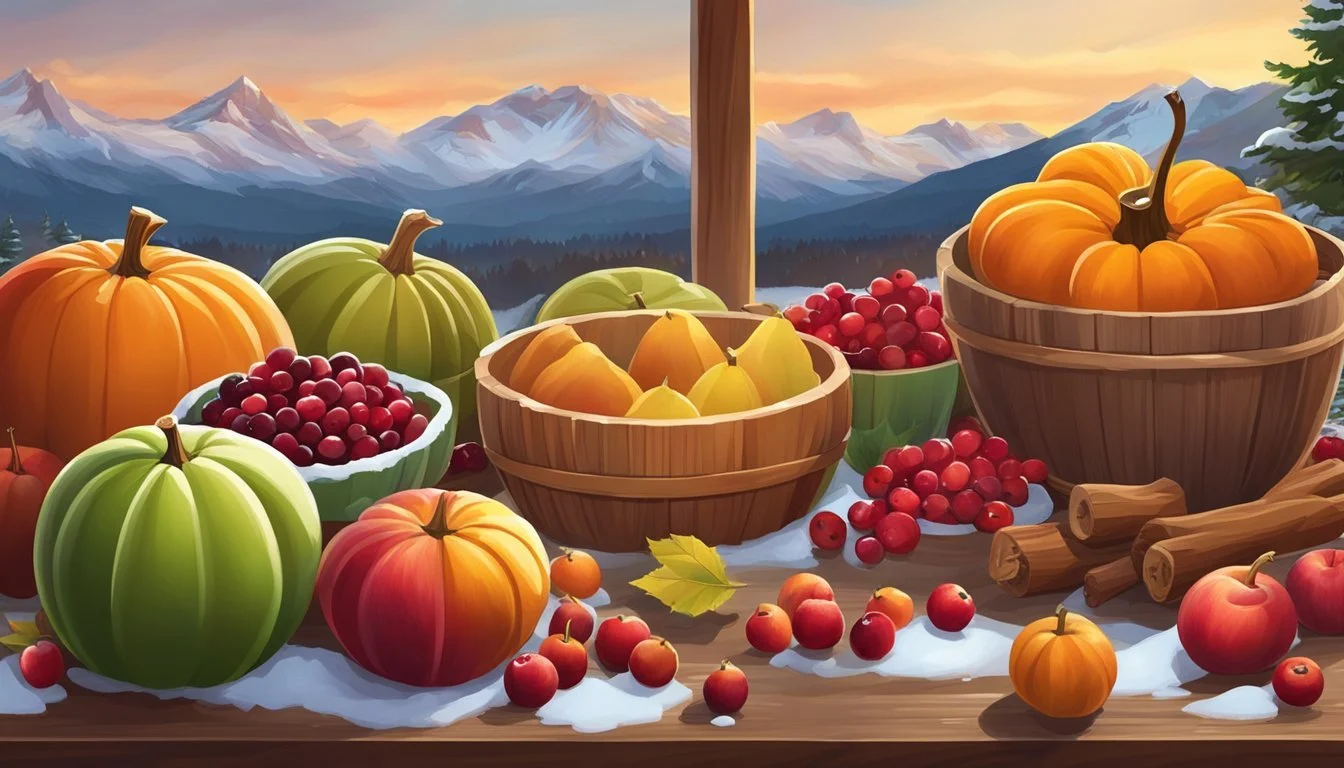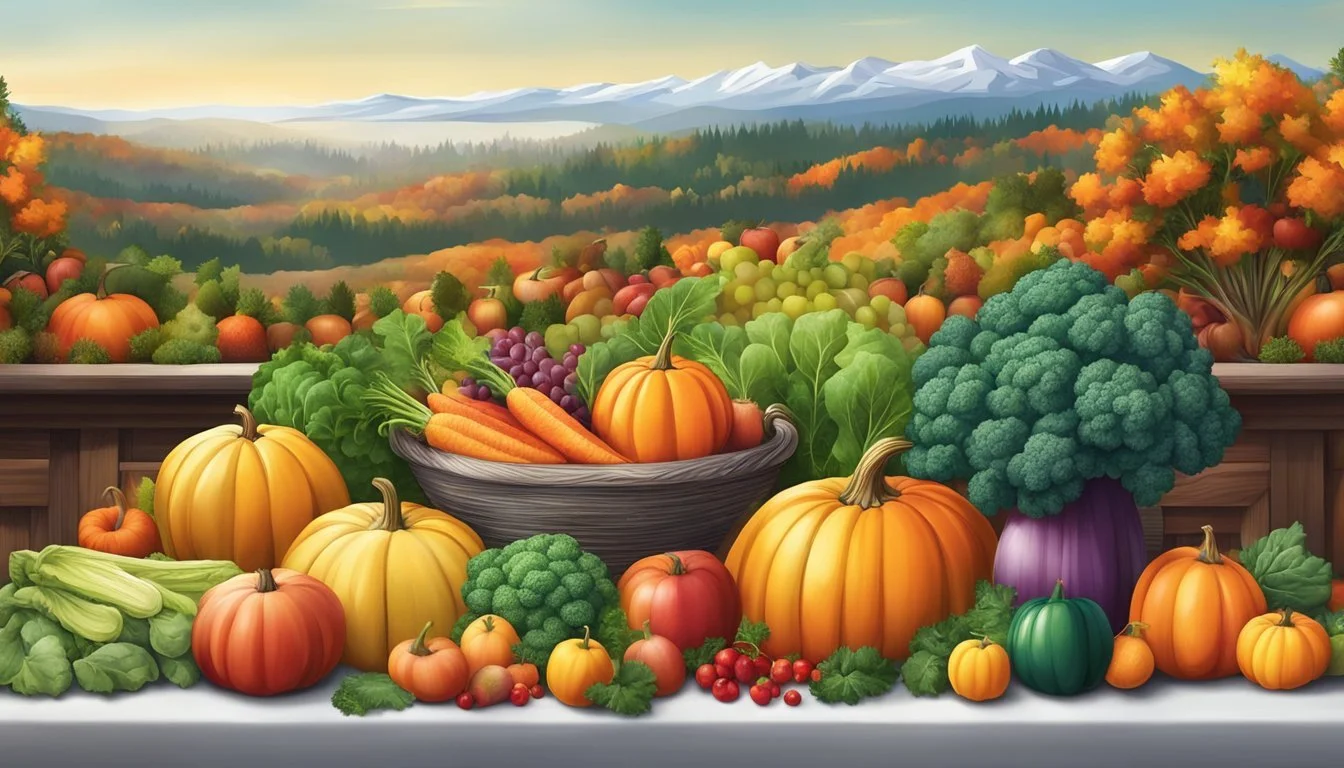Alaska Seasonal Fruit & Vegetables in November
Your Guide to Fresh Produce
This Article is Part of our Alaska Seasonal Fruit & Veg Calendar
November in Alaska presents a unique range of seasonal fruits and vegetables that have adapted to its shorter growing season and colder climate. During this time, local farmer's markets and grocers are stocked with produce that has either been harvested before the frost and stored for winter use or grown in the hardy conditions that the Alaskan late autumn can provide.
The produce available in November largely consists of root vegetables and hardy greens, which can withstand colder temperatures. Carrots (how long do carrots last?), potatoes, and turnips are staple root crops, offering robust flavors and essential nutrients. Greens such as kale and collard greens (how long do collard greens last?), along with cruciferous vegetables like cauliflower (how long does cauliflower last?) and Brussels sprouts, are also at their peak, capable of surviving the first frosts of the Alaskan autumn with their flavor even enhanced by the colder weather.
While the scope for seasonal fruits in Alaska during November is limited due to the climate, options such as cranberries can still be found. They have a short harvest window that can sometimes extend into early November. These fruits are highly valued for their tart flavor and are often used in traditional Alaskan recipes and for Thanksgiving celebrations.
Understanding Alaska's Seasons
Alaska's agricultural seasonality significantly shapes local food availability, with November marking the end of the traditional harvest period.
The Importance of Seasonality
Seasonality is paramount in Alaskan agriculture due to the state's unique climatic conditions. Fall—an important transitional season—sees the end of many crops' growth cycles. As winter approaches, the focus shifts to harvesting and preparing for the colder months. Residents and farmers understand that the seasons dictate the types of produce available, and they rely heavily on preserved goods from earlier bountiful months as fresh harvests dwindle.
November's Place in Alaska's Harvest Calendar
In November, Alaska is deep into autumn, and most fresh outdoor farming has concluded due to the freezing temperatures. It's a time when traditionally there are no outdoor crops labeled as in season. However, select indoor-grown or cold-storaged produce might still be available, carrying over from earlier harvests. The Alaskan harvest calendar is quite abbreviated compared to lower latitudes, with the bulk of outdoor vegetable and fruit harvesting completed by the end of September.
Seasonal Fruits in Alaska
In November, Alaskans take advantage of the tail end of the local harvest season and enjoy a variety of imported fruits that become more prevalent in the markets.
Late Harvest Fruits
As winter approaches, the availability of locally grown fruits in Alaska becomes more limited. However, certain hardy varieties reach their peak at this time:
Apples: These remain sturdy in cooler climates and can be found in local markets.
Cranberries: Wild Alaskan cranberries are typically harvested through late fall.
Local fruits are scarce beyond these varieties, as the Alaskan climate is not conducive to a wide range of late-season fruit crops.
Citrus and Tropical Fruits in Alaskan Markets
Come November, Alaskan grocers stock up on a selection of imported citrus and tropical fruits to meet consumer demand:
Oranges: A popular citrus fruit, often available in various types.
Lemons: Commonly found and used for their zest and juice.
Kiwi: This fruit is typically sourced from warmer climates and sold in Alaska during this time.
It is also possible to find other imported fruits like pears and pomegranates. However, products like these are not locally grown and are shipped from farms at much warmer latitudes.
Alaska's Seasonal Vegetables
In November, Alaska's selection of vegetables is rich in hardy root varieties and robust squashes, along with some resilient green vegetables that withstand the cooler temperatures.
Root Vegetables and Squashes
Root vegetables flourish in the Alaskan fall. Despite the cold setting in, these hardy plants continue to thrive and are often harvested this month.
Beets (how long do beets last?): Notable for their deep red hues and sweet flavor.
Carrots: Alaskan carrots are especially sweet, attributed to the state's cool soil.
Potatoes: A versatile staple with numerous varieties available.
Turnips: Often harvested before the deep freeze, providing a robust flavor.
Onions: Essential for storage, onions are a hardy crop staple in Alaskan kitchens.
Winter squash is also a seasonal favorite, with a few types that fare well in the colder climate.
Butternut Squash: (how long does butternut squash last?) Known for a sweet, nutty taste and is versatile in recipes.
Acorn Squash: Small in size but rich in flavor, suitable for baking and stuffing.
Green Vegetables Thriving in Late Fall
A group of resilient green vegetables persists through Alaska's November chill, providing a fresh burst of nutrition.
Kale: Stands up to frost, with the cold even enhancing its flavor.
Spinach: Another cold-hardy vegetable that can handle the November weather.
Brussels Sprouts: These develop sweeter tastes after a few frosts.
Broccoli and Cauliflower: While not as frost-tolerant as kale, these can still perform well if the winter onset is mild.
Cabbage: Known for its durability, it often lasts well into the winter months.
Alaskan gardeners take advantage of the state's unique growing conditions to extend the harvest of these vegetables into the late fall.
Incorporating Seasonal Produce into Meals
In Alaska, November brings shorter days and colder weather, making it the perfect time to turn to locally sourced produce for warm, nourishing meals. Utilizing seasonal ingredients not only supports the local economy but also ensures the freshest flavors.
Comforting Soups and Stews
Soups and stews are ideal for incorporating a variety of seasonal vegetables, such as cabbage and cauliflower. These ingredients can be roasted to enhance their natural sweetness before being added to a soup or stew, offering layers of flavor. One can also explore the depths of flavor by adding mashed root vegetables like rutabagas to thicken and enrich the broth.
Roasted Cauliflower Soup:
Roast cauliflower until golden.
Simmer with vegetable stock and blend until smooth.
Salads with a Hearty Autumn Twist
Salads in November need not be bland; they can be hearty and refreshing with the right ingredients. Cabbage serves as an excellent base for salads, providing a crisp texture that withstands bold dressings. Adding roasted vegetables like beets or cooked grains can transform a simple salad into a substantive dish.
Hearty Cabbage & Roasted Beet Salad:
Combine shredded cabbage with roasted beets.
Dress in a vinaigrette made with local herbs.
Main Dishes Featuring Seasonal Ingredients
Main dishes can capitalize on the freshness of seasonal produce. Incorporate roasted root vegetables as sides or integrate them into a main dish for a comforting and satisfying meal. Foods like rutabagas, traditionally stored well into winter, can be mashed alongside potatoes for a twist on classic sides.
Baked Salmon with Mashed Rutabaga:
Season fresh salmon and bake until flaky.
Serve with a side of mashed rutabaga and potatoes.
Nutritional Benefits of Seasonal Eating
Consuming seasonal fruits and vegetables in Alaska during the fall offers significant nutritional advantages. They are often at their peak in flavor and nutrient content, providing an array of vitamins, minerals, and other beneficial compounds.
Vitamins and Minerals in Fall Produce
Seasonal vegetables like pumpkins are rich in vitamins and minerals. Pumpkins contain vitamin A, which is crucial for eye health, skin integrity, and immune function. They are also a good source of vitamin C, known for boosting immunity and aiding in the absorption of iron. Alongside these, pumpkin offers potassium—vital for heart function—and traces of calcium and magnesium, which support bone health. Root vegetables such as carrots and beets also thrive in this season, offering similar nutrient profiles.
Here is the nutrient content for 100 grams of raw pumpkin:
Vitamin A: 8513 IU (170% DV)
Vitamin C: 9 mg (15% DV)
Potassium: 340 mg (10% DV)
Calcium: 21 mg (2% DV)
Magnesium: 12 mg (3% DV)
(*DV = Daily Value)
Fiber-rich Fruits and Vegetables for Wellness
Including seasonal fruits and vegetables in one's diet can also contribute significantly to daily fiber intake, aiding digestion and enhancing one’s overall sense of wellness. Fiber has been tied to improved gut health and can help regulate blood sugar levels. For instance, Alaskan berries, which can be harvested and stored for the winter, provide a hearty dose of fiber alongside their high antioxidant contents, which can prevent oxidative damage to cells. Vegetables like Brussels sprouts and kale, which can withstand cooler temperatures, are excellent choices for adding both fiber and essential nutrients to a fall diet in Alaska.
Shopping for Seasonal Produce
In November, Alaska's seasonal produce is limited due to the harsh climate. However, consumers can still find quality options that are fresh and flavorful. Selecting the best products requires knowing where to shop and what to look for.
Finding Quality and Freshness
When searching for fresh produce in November, Alaskans should look for firmness in root vegetables and an earthy smell that indicates recent harvest. Quality options are often available in their raw state, displaying vibrant colors and a lack of soft spots or blemishes. For these cold-resistant varieties, like cabbages or potatoes, their firm texture is a good indicator of freshness.
Alaskan Grocery Stores and Farmers' Markets
Grocery stores in Alaska cater to the demand for fresh, local produce by offering items that are in season. They carefully source from local producers whenever possible. Shoppers should keep an eye out for signage indicating Alaskan-grown produce, supporting the local economy and reducing food miles.
Farmers' markets, although fewer in November, remain a quintessential place to find seasonal produce. They typically feature a selection of products brought directly from the farm, ensuring they are as fresh as possible. The markets also provide the opportunity to speak directly with growers, gaining insights into how and where the produce was cultivated.
The Role of Seasonal Produce in Special Occasions
Seasonal produce plays a critical role in Alaskan celebrations, particularly when it comes to incorporating fresh, locally-sourced ingredients into special occasion menus, where they bring distinctive flavors and a touch of tradition to the table.
Thanksgiving and Seasonal Abundance
Thanksgiving in Alaska is a time when the harvest's yield is celebrated, often with a focus on late-season crops. Root vegetables like potatoes, carrots, and beets, which are stored well into November, become the stars of the Thanksgiving table. They commonly appear in traditional dishes, such as roasted carrots glazed with local honey or mashed potatoes. Alaskans might also include preserved berries in their Thanksgiving desserts, which add a sweet and nutty flavor to pies and cobblers. These culinary traditions not only enhance the festive experience but also reflect the state's agricultural rhythm.
Festive Dishes and Seasonal Flavors
Alaskan chefs and home cooks often use November's seasonal produce to create festive dishes rich in both flavor and heritage. Desserts are particularly influenced by what’s available, featuring pumpkins and cranberries that lend a sweet and tangy taste, respectively, to various confections.
Pumpkin pies and cranberry sauces are quintessential examples, with the pumpkin providing a creamy texture and a subtly sweet, earthy flavor to pies, while cranberries offer a sharp contrast with their bold tartness.
Brussels sprouts and cabbages are other common seasonal vegetables that make their way into side dishes, often enhanced with a nutty crunch of roasted nuts, showcasing the versatility of November’s produce in savory selections.
Alaskan festivities leverage these late-harvested vegetables and fruits to foster a sense of community and continuity as they gather to share meals that are unique to their local environment and the season.
Preserving Seasonal Flavors
With the right techniques, Alaskans can enjoy the fruits and vegetables of the late harvest well into the winter months. The focus here is on practical methods for extending the freshness of produce and capitalizing on the flavors available in November.
Techniques for Extending the Shelf Life of Produce
Dry Storage: Many root vegetables and hearty produce such as potatoes, turnips, and pumpkins remain edible for long periods when stored in cool, dry, and dark environments. Pumpkins, known for their smooth texture and sweet flavor, benefit from this method, retaining quality for later use.
Freezing: Fresh cranberries, harvested in the fall, can be frozen to extend their usability. They should be spread out on a baking sheet to freeze individually and then transferred into airtight bags. This preserves the berries' integrity and prevents clumping, ensuring that the cranberries remain smooth when thawed.
Canning: Can be an effective way to preserve a variety of produce, including late-harvest cranberries and pumpkin. Cranberries can be made into sauces or jams, and pumpkin puree can be canned for future use in baking and cooking.
Pickling: This method not only extends the shelf life of vegetables but also adds unique flavors. Vegetables like cabbage and turnips can be pickled, and the process can involve either a vinegar-based brine or lacto-fermentation for probiotic benefits.
Making the Most of the Late Harvest
Utilize Every Part: When dealing with late harvest produce, it's important to utilize as much of the produce as possible. Pumpkin seeds (how long do pumpkin seeds last?), for example, can be roasted for a nutritious snack, while the flesh can be used for soups, pies, or preserved for future recipes.
Preservation Recipes: Specific recipes designed for preserving the harvest can maximize the taste and longevity of the produce. Cranberry relishes and pumpkin chutneys are seasonal favorites that capture the essence of November's bounty and allow for enjoyment well past the harvest season.
By applying these preservation techniques, individuals ensure a continuous supply of seasonal flavors, adding variety and nutrition to their meals even as the growing season in Alaska comes to a close.
Environmental and Economic Impact
Alaska's harsh climate presents unique challenges and opportunities for local agriculture. Emphasizing local production of seasonal fruits and vegetables can yield significant environmental and economic benefits.
Supporting Local Agriculture in Alaska
Local agriculture in Alaska, though limited by the state’s cold climate, plays a crucial role in its economy. The production of root vegetables and other cold-hardy crops during the short growing season contributes to economic sustainability. State-supported initiatives can enhance the viability of local farms, increasing the percentage of locally-produced food from the current 5%. This bolstering of local agriculture also addresses food security issues, as Alaska imports a majority of its food, increasing its vulnerability to supply chain disruptions.
Economic benefits: Supporting Alaskan farms keeps money within the local economy and can create jobs.
Food security: Local production of food reduces dependency on external supply chains.
Reducing Carbon Footprint with Seasonal Choices
Choosing to consume seasonal fruits and vegetables can significantly reduce one's carbon footprint. When Alaskans opt for produce that aligns with the state's growing season, they eliminate the emissions associated with transporting food over long distances. Additionally, purchasing local and seasonal produce can lead to a reduction in food waste, as these items do not require extended storage times.
Transport: Reduced reliance on imported goods lowers transportation emissions.
Sustainability: Seasonal consumption supports sustainable agricultural practices by aligning with the state's natural growing cycles.
Consuming locally grown, seasonal foods in Alaska is not only an environmentally sustainable choice but can also fortify the state’s economy and resilience against food-related diseases.











